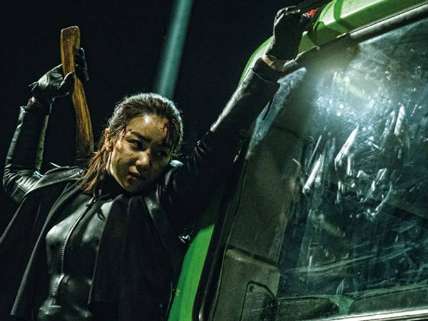Movie Review: The Villainess
Return of Lady Vengeance.

Among the several nuts-o-rama action scenes in The Villainess, a new movie from South Korean frenzy specialist Jung Byung-gil, is an entirely crazed auto chase in which the bad-ass lady of the title, pursuing a bus full of thugs, blows out the windshield of her car, climbs out onto the hood—with one hand stretched back inside to continue steering—then rises up and leaps onto the outside of the bus, hanging on desperately as the wind thwacks her around and the heavily armed bad guys inside make things even more difficult. Then…
Well, let's just say the scene goes on for a while, and it doesn't get any less delirious. Jung is a director for whom too much is always just the right amount—a compliment, of course. With its swarming squads of black-suited assassins, its overload of guns, swords and corpses, and its cold-eyed killer women, his movie blithely recalls such earlier revenge thrillers as the Kill Bills, the John Wicks (already a part of the international action pantheon), and La Femme Nikita, with maybe a faint whiff of the old Japanese "Baby Cart" pictures as well (little kids make several intrusions here).
I suppose someone somewhere might offer a hat tip to Jung for leavening his virtuoso mayhem with interludes of low-key chat and nuzzly sentiment; I wouldn't be among those people, however. Because every moment in this movie in which someone isn't taking a hatchet to the head or a barbell to the knees is a moment lost to creeping ennui. Jung appears to have no interest in linear storytelling, and his penchant for sudden flashbacks is disorienting. The script, by the director and his brother, Byeong-sik Jung, a writer of comic books, gives us two adult versions of the film's protagonist, a fierce young woman named Sook-hee. We also meet her as a little girl when Jung takes us back into her childhood, where we see her peering out from under a bed as her father is murdered before her eyes by an unseen killer (who for some reason is whistling "When You and I Were Young, Maggie").
With all of the who/what/where involved, I'm still not sure I've completely grasped the story here. Jung launches the movie with another of his way-over-the-top action eruptions—a mysterious figure creeping down the puke-green hallway of an urban meth lab, an outburst of splattery arterial hubbub as this character fends off what seems like a legion of attackers. The shadowy interloper is eventually revealed to be Sook-hee, and very quickly a top intelligence chief named Kwon (steely Seo-hyeong Kim) decides that she would be a worthy addition to the agency's assassination program. Although Sook-hee's personal goal is to track down and terminate the man who killed her father, Kwon is very persuasive. Sook-hee signs up and is given all the usual training in the lethal arts, as well as a heavy overlay of plastic surgery (from which she emerges in the form of a new actress, Kim Ok-bin, star of the Park Chan-wook vampire flick Thirst). She is then installed in a Seoul apartment building, where her new neighbor—a young guy named Hyun-soo (Sung Jun)—immediately starts making cute with her. Like Sook-hee, he also has deep secrets.
Most of the movie's narrative exposition can be justified, I guess. If only there weren't so much of it—especially since the picture is overlong at two hours and nine minutes and could use a trim. Far more fun is setting out with Sook-hee on one of her violent intel assignments—there's a great one in a geisha house, and a classic how-on-earth-did-they-shoot-that motorcycle chase through a tunnel that seems unlikely to be equaled anytime soon). The action scenes show off the film's strongest components: Park Jung-hun's extraordinary hand-held cinematography; Heo Sun-mi's scalpel-sharp editing; and the great clattery score by Koo Ja wan, which sounds like an earthquake in a cowbell factory (in a good way). This stuff speaks for itself.
